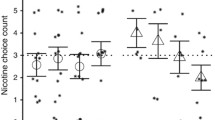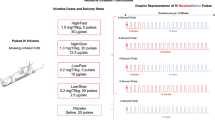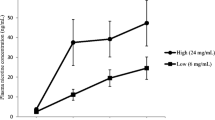Abstract
Rationale
The nicotine delivery rate is a key feature of tobacco product design, yet there have been limited human studies examining the effects of nicotine as a function of delivery rate.
Objective
We developed an intravenous nicotine infusion protocol to evaluate differential effects of nicotine delivery rate on subjective drug effects, smoking urges, abstinence symptoms, heart rate, and blood pressure.
Methods
Eighteen non-treatment seeking, overnight abstinent male and female smokers (18 to 30 years old), who smoked ≥ 5 cigarettes per day for the past year completed four sessions, in which they were randomly assigned to a saline infusion, or a 1 mg per 70-kg body weight dose of nicotine delivered over 1, 5, or 10 min at rates of 0.24, 0.048, or 0.024 μg/kg/s, respectively.
Results
Smoking urges, as assessed by the Brief Questionnaire of Smoking Urges, were reduced relative to placebo for the 1- and 5-min infusion, but not the 10-min infusion. Although the 1- and 5-min infusions reduced smoking urges to a similar extent, the 1-min infusion induced a greater heart rate and blood pressure increase. Changes to subjective drug effects, heart rate, and blood pressure delineate the differential effects of nicotine delivery rate for these outcomes.
Conclusions
We have characterized the delivery rate-response curve for a nicotine dose that is roughly the amount of nicotine (~ 1 mg) delivered by smoking a standard tobacco cigarette. Our findings reinforce the importance of nicotine delivery rate when evaluating the potential effects of nicotine from tobacco products.




Similar content being viewed by others
References
Abreu ME, Bigelow GE, Fleisher L, Walsh SL (2001) Effect of intravenous injection speed on responses to cocaine and hydromorphone in humans. Psychopharmacology 154:76–84
Babic M, Schuchardt M, Tolle M, van der Giet M (2019) In times of tobacco-free nicotine consumption: the influence of nicotine on vascular calcification. Eur J Clin Invest:e13077
Benowitz NL (2008) Clinical pharmacology of nicotine: implications for understanding, preventing, and treating tobacco addiction. Clin Pharmacol Ther 83:531–541
Benowitz NL, Jacob P (1984) Daily intake of nicotine during cigarette-smoking. Clin Pharmacol Ther 35:499–504
Benowitz NL, St Helen G, Dempsey DA, Jacob P 3rd, Tyndale RF (2016) Disposition kinetics and metabolism of nicotine and cotinine in African American smokers: impact of CYP2A6 genetic variation and enzymatic activity. Pharmacogenet Genomics 26:340–350
Berridge MS, Apana SM, Nagano KK, Berridge CE, Leisure GP et al (2010) Smoking produces rapid rise of [11C]nicotine in human brain. Psychopharmacology 209:383–394
Breland A, Soule E, Lopez A, Ramoa C, El-Hellani A et al (2017) Electronic cigarettes: what are they and what do they do? Ann N Y Acad Sci 1394:5–30
Brown CJ, Cheng JM (2014) Electronic cigarettes: product characterisation and design considerations. Tob Control 23(Suppl 2):ii4–i10
Bullen C, McRobbie H, Thornley S, Glover M, Lin R, Laugesen M (2010) Effect of an electronic nicotine delivery device (e cigarette) on desire to smoke and withdrawal, user preferences and nicotine delivery: randomised cross-over trial. Tob Control 19:98–103
Caraballo RS, Asman K (2011) Epidemiology of menthol cigarette use in the United States. Tob Induc Dis 9(Suppl 1):S1
Cox LS, Tiffany ST, Christen AG (2001) Evaluation of the brief questionnaire of smoking urges (QSU-brief) in laboratory and clinical settings. Nicotine Tob Res 3:7–16
Dar R, Frenk H (2007) Reevaluating the nicotine delivery kinetics hypothesis. Psychopharmacology 192:1–7
De Wit H, Dudish S, Ambre J (1993) Subjective and behavioral effects of diazepam depend on its rate of onset. Psychopharmacology 112:324–330
DeVito EE, Herman AI, Waters AJ, Valentine GW, Sofuoglu M (2014) Subjective, physiological, and cognitive responses to intravenous nicotine: effects of sex and menstrual cycle phase. Neuropsychopharmacology 39:1431–1440
DeVito EE, Valentine GW, Herman AI, Jensen KP, Sofuoglu M (2016) Effect of menthol-preferring status on response to intravenous nicotine. Tob Regul Sci 2:317–328
Djordjevic MV, Stellman SD, Zang E (2000) Doses of nicotine and lung carcinogens delivered to cigarette smokers. J Natl Cancer Inst 92:106–111
Eissenberg T, Shihadeh A (2015) Nicotine flux: a potentially important tool for regulating electronic cigarettes. Nicotine Tob Res 17:165–167
Erzurumluoglu AM, Liu M, Jackson VE, Barnes DR, Datta G et al (2019) Meta-analysis of up to 622,409 individuals identifies 40 novel smoking behaviour associated genetic loci. Mol Psychiatry
Gómez-Coronado N, Walker AJ, Berk M, Dodd S (2018) Current and emerging pharmacotherapies for cessation of tobacco smoking. Pharmacotherapy 38:235–258
Goodwin AK, Hiranita T, Paule MG (2015) The reinforcing effects of nicotine in humans and nonhuman primates: a review of intravenous self-administration evidence and future directions for research. Nicotine Tob Res 17:1297–1310
Henningfield JE, Keenan RM (1993) Nicotine delivery kinetics and abuse liability. J Consult Clin Psychol 61:743–750
Henningfield JE, Hatsukami DK, Zeller M, Peters E (2011) Conference on abuse liability and appeal of tobacco products: conclusions and recommendations. Drug Alcohol Depend 116:1–7
Jensen KP, DeVito EE, Herman AI, Valentine GW, Gelernter J, Sofuoglu M (2015a) A CHRNA5 smoking risk variant decreases the aversive effects of nicotine in humans. Neuropsychopharmacology 40:2813–2821
Jensen KP, Herman AI, Morean ME, Kranzler HR, Gelernter J, Sofuoglu M (2015b) FKBP5 variation is associated with the acute and chronic effects of nicotine. Pharmacogenomics J 15:340–346
Jensen KP, DeVito EE, Valentine G, Gueorguieva R, Sofuoglu M (2016) Intravenous nicotine self-administration in smokers: dose-response function and sex differences. Neuropsychopharmacology 41:2034–2040
Jensen KP, Smith AH, Herman AI, Farrer LA, Kranzler HR et al (2017) A protocadherin gene cluster regulatory variant is associated with nicotine withdrawal and the urge to smoke. Mol Psychiatry 22:242–249
Marsch LA, Bickel WK, Badger GJ, Rathmell JP, Swedberg MD, Jonzon B, Norsten-Höög C (2001) Effects of infusion rate of intravenously administered morphine on physiological, psychomotor, and self-reported measures in humans. J Pharmacol Exp Ther 299:1056–1065
Morean ME, de Wit H, King AC, Sofuoglu M, Rueger SY, O’Malley SS (2013) The drug effects questionnaire: psychometric support across three drug types. Psychopharmacology 227:177–192
Norton KJ, June KM, O'Connor RJ (2014) Initial puffing behaviors and subjective responses differ between an electronic nicotine delivery system and traditional cigarettes. Tob Induc Dis 12:17
Perkins KA, Lerman C, Keenan J, Fonte C, Coddington S (2004) Rate of nicotine onset from nicotine replacement therapy and acute responses in smokers. Nicotine Tob Res 6:501–507
Rose JE, Behm FM, Westman EC, Coleman RE (1999) Arterial nicotine kinetics during cigarette smoking and intravenous nicotine administration: implications for addiction. Drug Alcohol Depend 56:99–107
Ruther T, Hagedorn D, Schiela K, Schettgen T, Osiander-Fuchs H et al (2018) Nicotine delivery efficiency of first- and second-generation e-cigarettes and its impact on relief of craving during the acute phase of use. Int J Hyg Environ Health 221:191–198
Samaha AN, Yau WY, Yang P, Robinson TE (2005) Rapid delivery of nicotine promotes behavioral sensitization and alters its neurobiological impact. Biol Psychiatry 57:351–360
Schneider NG, Olmstead RE, Nides M, Mody FV, Otte-Colquette P, Doan K, Patel S (2004) Comparative testing of 5 nicotine systems: initial use and preferences. Am J Health Behav 28:72–86
Schuh KJ, Schuh LM, Henningfield JE, Stitzer ML (1997) Nicotine nasal spray and vapor inhaler: abuse liability assessment. Psychopharmacology 130:352–361
Shihadeh A, Eissenberg T (2015) Electronic cigarette effectiveness and abuse liability: predicting and regulating nicotine flux. Nicotine Tob Res 17:158–162
Sofuoglu M, Herman AI, Nadim H, Jatlow P (2012) Rapid nicotine clearance is associated with greater reward and heart rate increases from intravenous nicotine. Neuropsychopharmacology 37:1509–1516
Tiffany ST, Drobes DJ (1991) The development and initial validation of a questionnaire on smoking urges. Br J Addict 86:1467–1476
Toll BA, O'Malley SS, McKee SA, Salovey P, Krishnan-Sarin S (2007) Confirmatory factor analysis of the Minnesota nicotine withdrawal scale. Psychol Addict Behav 21:216–225
US Food and Drug Administration (FDA) (2016) Draft guidance on premarket tobacco product applications for electronic nicotine delivery systems
US Food and Drug Administration (FDA) (2017) Assessment of abuse potential of drugs: guidance for industry
Vansickel AR, Cobb CO, Weaver MF, Eissenberg TE (2010) A clinical laboratory model for evaluating the acute effects of electronic “cigarettes”: nicotine delivery profile and cardiovascular and subjective effects. Cancer Epidemiol Biomark Prev 19:1945–1953
Wakasa Y, Takada K, Yanagita T (1995) Reinforcing effect as a function of infusion speed in intravenous self-administration of nicotine in rhesus monkeys. Nihon Shinkei Seishin Yakurigaku Zasshi 15:53–59
West R, Ussher M (2010) Is the ten-item questionnaire of smoking urges (QSU-brief) more sensitive to abstinence than shorter craving measures? Psychopharmacology 208:427–432
Wing VC, Shoaib M (2013) Effect of infusion rate on intravenous nicotine self-administration in rats. Behav Pharmacol 24:517–522
Acknowledgments
We are grateful to Ellen Mitchell, Lance Barnes, and Stacy Minnix for providing excellent technical assistance.
Funding
Research reported in this publication was supported by grant number R03DA043004 and U54DA036151 from NIDA and FDA Center for Tobacco Products (CTP). The content is solely the responsibility of the authors and does not necessarily represent the official views of the NIH or the Food and Drug Administration.
Author information
Authors and Affiliations
Corresponding author
Ethics declarations
All participants provided written informed consent before participating in the study, and participants were paid for their participation. Institutional review boards at Yale University and the VA Connecticut Healthcare System approved the study.
Conflict of interest
Since participating in this research, KPJ has become an employee of Celgene Corporation and Bristol-Myers Squibb and declares no conflict of interest. All other authors declare no potential conflicts of interest.
Additional information
Publisher’s note
Springer Nature remains neutral with regard to jurisdictional claims in published maps and institutional affiliations.
Electronic supplementary material
ESM 1
(DOCX 408 kb).
Rights and permissions
About this article
Cite this article
Jensen, K.P., Valentine, G., Gueorguieva, R. et al. Differential effects of nicotine delivery rate on subjective drug effects, urges to smoke, heart rate and blood pressure in tobacco smokers. Psychopharmacology 237, 1359–1369 (2020). https://doi.org/10.1007/s00213-020-05463-6
Received:
Accepted:
Published:
Issue Date:
DOI: https://doi.org/10.1007/s00213-020-05463-6




